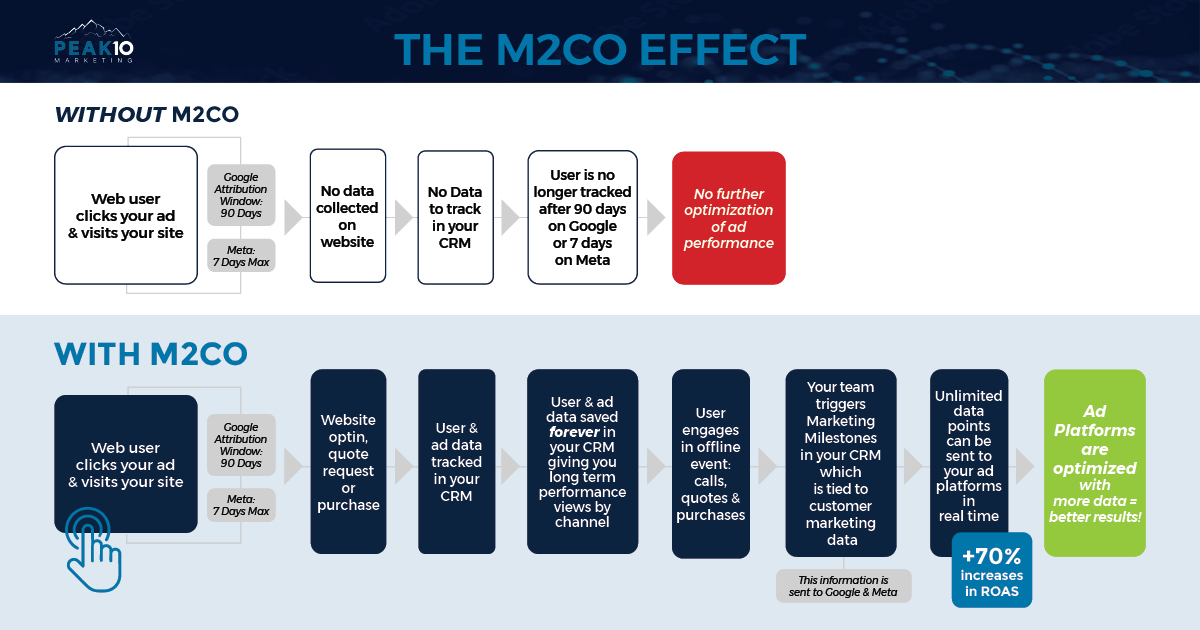Why Most Manufacturers Overpay for Digital Ads (and How to Fix It with First-Party Data)

If you are a manufacturer who advertises online but sells mostly offline, you have probably felt the frustration. The ad platforms keep telling you your campaigns are performing. Clicks are flowing, impressions are stacking up, and leads look healthy on paper. But when you compare those numbers to what is really happening in your sales pipeline, the story does not add up.
The reality is this: most manufacturers are paying too much for traffic that does not convert, because the ad platforms are optimizing to the wrong signals. And it is not your fault. The way Google and Meta are built simply does not align with how manufacturers actually sell.
So why does this happen, and what can you do about it?
Why Manufacturers Get Burned by Ad Platforms
Google and Meta’s algorithms are hungry machines. They thrive on rapid feedback, short cycles where someone clicks, buys, and confirms the ad worked. That is why e-commerce brands fit their systems so well. The loop closes in a day or even an hour.
Manufacturers, on the other hand, live in a different world. Your products are complex. Your sales cycles often stretch weeks or months. A conversion is not a checkout button, it is a quote request, a technical consultation, or a signed purchase order.
That delay creates a major blind spot. From the platform’s perspective, your campaigns look like under-performers because the sale does not show up in their system. Imagine running a campaign that drives $300,000 in quotes, but none of those quotes tie back to the ad click in Google Ads.
What will the algorithm do? It will cut spend from the campaign that is actually working, and reallocate it to something cheaper but less effective.
That is how manufacturers end up overpaying. Not because your campaigns are bad, but because the system is not seeing what really matters.

Why Clicks and Leads Do Not Tell the Full Story
A click is just a handshake. It is a first step, not proof of interest. And a form fill does not guarantee intent either.
We have all seen it, marketing teams celebrating a spike in leads, while the sales team groans because most of those leads are tire kickers. If the algorithm is fed those empty signals, it keeps optimizing for more of them. That is how cost per lead goes down while cost per quote or cost per sale goes up.
For manufacturers, the real milestones are deeper in the funnel. A booked sales call. A detailed quote request. A closed won opportunity. That is the data you should be optimizing to, but the platforms will not see it unless you put it in front of them.
First-Party Data: The Advantage You Already Own
The good news is that you already have the answer sitting inside your CRM.
First-party data, the information you collect directly from your customers, is the most valuable asset you have. It is not dependent on cookies, pixels, or third-party trackers. It is yours. And it captures the full journey, from the first inquiry all the way to the final sale.
For manufacturers, this means your CRM is tracking the milestones that matter:
- Leads that come in through forms, phone calls, or chats
- Sales appointments booked by your team
- Quotes issued to serious buyers
- Closed deals that bring in revenue
These milestones are what define success in your business, and they are far more reliable than any click the platforms can see.
Teaching the Algorithms What a Good Customer Looks Like
Think about training a new machinist. If you only ever show them scrap parts, they will assume that is the standard. But if you hand them the finished piece, show them what quality looks like, and walk them through the process, their output improves dramatically.
Ad platforms work the same way. If all you feed them are clicks and surface-level conversions, they will keep chasing shallow signals. But if you feed them verified data from your CRM, actual quotes and closed deals, the algorithm learns to recognize and prioritize the customers that matter.
This is where the shift happens. Instead of optimizing for traffic, you are optimizing for revenue.
How to Turn Data Into Growth
The mechanics of syncing data can sound technical, but the principle is simple, connect your CRM to your ad platforms so they see the same milestones your sales team sees.
In Google Ads, this means using offline conversion imports. Every time a lead turns into a quote or a closed deal, that event gets matched back to the original click and fed into the algorithm.
In Meta, this means using the Conversions API. Instead of relying on a pixel, you send validated conversions directly from your CRM to Meta’s system.
When you do this consistently, your campaigns stop chasing surface metrics and start chasing the real thing, revenue generating customers.
Why a System Matters
Of course, it is not enough to just pipe data back and hope for the best. Without rules, filters, and strategy, you risk overwhelming the system with noise. That is why at Peak 10 Marketing, we built the M2CO Method.
M2CO is a structured process that:
- Captures the right milestones in your CRM
- Validates and cleans the data so only quality signals get passed back
- Syncs those signals with Google and Meta using API integrations
- Creates a feedback loop that continuously improves campaign optimization
It is not another tool, it is process improvement applied to advertising. And it ensures that every dollar you spend is working toward measurable outcomes.
The Takeaway for Manufacturers
If you have been frustrated with rising ad costs and flat results, the problem is not your product or your market. The problem is the data loop. The platforms are not seeing what actually drives your sales, so they are making decisions on incomplete information.
You do not need to accept that. You already have the data that matters. The next step is using it to take control of your optimization.
When you stop paying for empty clicks and start optimizing for quotes and sales, your campaigns become an engine for real growth.
If you are ready to cut waste and get clarity, explore the full article on the M2CO Method. Or, if you want to see how our system could work for your business, join us for a Growth Engineering Session and start your growth journey today.
Related Resources
Learn More About the Future of Digital Marketing
The future belongs to those who build it. Discover how to engineer marketing systems that perform as precisely as your production line.




